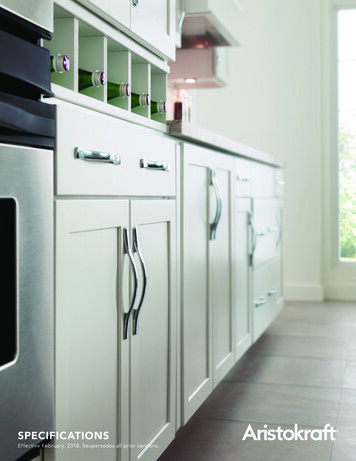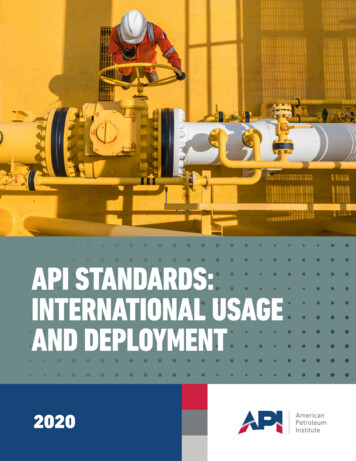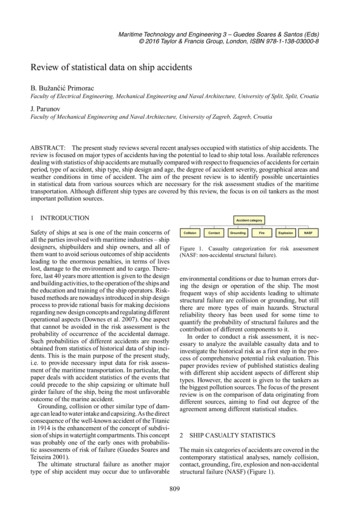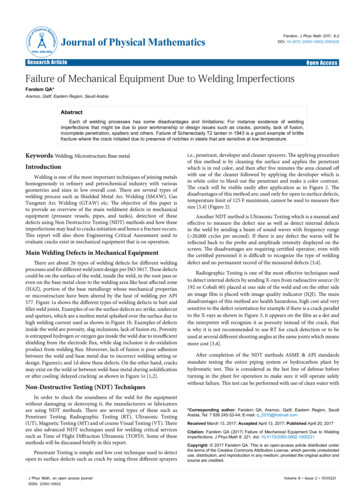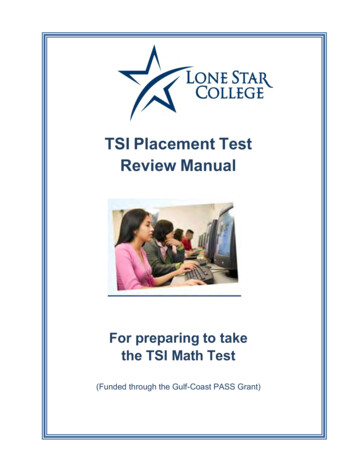
Transcription
Part of the CaldervaleTechnology GroupGood Practice Guide toButt Fusion JointingPioneers inAutomaticButt Fusion
Contents0102030506IntroductionGetting StartedMaking The JointDo’s and Don’tsSafety Notice
IntroductionThis good practice guide to Butt Fusion Jointing provides basicinformation to enable the operative to:1234567Understand equipment required.Understand the principles of polyethylene (PE) pipe butt fusion jointing.Identify pipe and appropriate fitting markings.Site of equipment.Carry out pre-jointing machine and equipment checks.Make satisfactory butt fusion joints across a range of pipe sizes.Inspect for and identify acceptable quality joints including de-beading.The butt fusion machine featured is the Gator2 250. The principles outlined in the guide are applicable to all butt fusionmachines manufactured by Fusion Equipment Limited.GOOD PRACTICE GUIDE TO BUTT FUSION JOINTING01
Getting StartedEquipmentSiting Equipment Generator of suitable size to power butt fusionmachine – refer to manufacturer’s literature forpower requirement. Butt fusion machine of suitable size and liners(if required). Pipe support rollers.The butt fusion machine should be placed on a suitableclean, dry base board or ground sheet inside a tent /shelter to minimise contamination and wind chill. Layout machine so there is enough room to get around themachine to carry out the work, route the cables and hosesso they don’t cause a trip hazard. Welding tent/shelter and ground sheet. External / internal de-beading tool. Pipe end covers. Pipe cutter. Indelible marker pen for marking beads.PrinciplesThe pipes to be joined are held in clamps which grip andre-round the pipe. Clamps are hydraulically operatedby hand pumps or electrically driven pumps. Clampmovement is controlled by the operator in the caseof manual / semi-automatic machines, in automaticmachines the computer controls clamp movement duringthe automatic cycle.Pipe ends are prepared by planing with an electricaldriven trimmer, then heated using an electrically powerednon-stick heater plates. When molten, the pipe ends arebrought together and held under pressure until cooled.Pre-jointing ChecksUse only equipment which has been regularly servicedand is in good condition. Ensure the correct jointingparameters for the machine and pipe being weldedare known and understood. Ensure that the generatoris maintained and serviced to the manufacturesrequirements, has sufficient fuel to carry out the workto be done. Ensure that the generator has been suitablyearthed to the generator manufactures requirements.Check that the heater plate coating is not damaged andis clean – wash only when cold with clean water and drywith a clean lint-free cloth or paper towel.Check that the trimmer is clean and that the blades arenot damaged and are in good condition. Ensure clampliners and securing screws of the correct size are availablefor the size of pipe to be jointed. Liners must be cleanand sit fully in the pipe clamps thus ensuring correctalignment. Check that the heater plate is at the correcttemperature. Ensure correct parameters are selected forpipe to be joined.Pipe Selection IDCheck that both pipes to be joined are of the samesize, SDR (standard dimension ratio) and material. Onlycompatible sizes and material should be joined together.If in doubt, seek advice from the pipe manufacturer. Pipeinformation is marked on the pipe at approximately onemetre intervals.02FUSION EQUIPMENT LIMITEDDummy JointTo make dummy welds follow the jointing proceduresor abort the cycle after the full soak time has elapsedthen open the machine and remove the heater. The firstprint out should read ‘Error 20: Abort during Fusion.’Alternatively, allow the joint to complete and cut out thejoint(s) once cooled. Some welding standards will forceone or two dummy welds.
Making The JointAutomatic Welding ProcedureThe welding procedure detailed below has beensummarised from Fusion Equipment Limitedcomprehensive operating instructions and is onlyintended as a guide. Always familiarise yourself fully withthe manufactures operating instruction, safety operationand controls before commencing work.Stop / Reset ButtonIn an emergency press the Emergency Stop Button on theback of the controller, when pressed it will immediately cutthe generator supply to the machine.2. Place pipes to be joined on the pipe support roller toreduce drag.3. Cover pipe ends that are to not being jointed toprevent draughts.4. Clean pipe ends inside and out (approx. 300mm) thenload and position pipes lightly against trimmer discs.5. Position toggle lever into place and use adjustmentknob (clockwise to tighten and anti-clockwise toloosen). Snap shut the fast clamps around the pipe.Dummy welds should be made (to remove any fineparticles from the heater plate) before every weldingsession, after changing from one pipe size to another andalso if the heater has been allowed to cool.Connection and Pipe Selection1. Connect heater, chassis and trimmer cables tothe computer.2. Ensure the hydraulic connections are clean and thenconnect to the controller.3Start the generator and then connect the controller tothe generator.4. Select the pipe size and type to be jointed.5. Confirm data.Pipe Preparation1. Load and secure trimmer into machine using the fastclamp system. Push down knobs and turn clockwiseto lock.6. Press ‘Green’ button on controller. Trimming willcontinue up to its programmed stop, but as soon as arunning swarf strip of full pipe thickness is visible, the‘feathering off’ phase can be initiated by pressing the‘Green’ button again. Without operator intervention,the machine will automatically enter the ‘feathering off’phase of the trimmer cycle.GOOD PRACTICE GUIDE TO BUTT FUSION JOINTING03
Making The Joint7. When trimming cycle is completed and carriage hasopened, remove trimmer and swarf. Be careful not totouch pipe ends.Making the Weld1. After the ‘check’ and prior to the ‘join’ phase securethe heater to the chassis. Push down knob and turnclockwise to lock.2. Press ‘Green’ button on computer this checks heatertemperature if the heater is correct temperature thenthe chassis will open. The chassis will not open untilthe correct temperature has been achieved.3. Insert the heater into the chassis, push home untilfully locked.Do not pull swarf up through trimmed pipe ends,as this may contaminate the pipe faces8. Visually check pipe ends for completeness of trimming.4. Press ‘Green’ button again. Fusion cycle will becarried out automatically. Display will give ‘relevant’information at all times.5. When controller display shows ‘JOINT COMPLETE’,press ‘Green’ button.9. Press ‘Green’ button to close carriage then visuallycheck pipe alignment, adjust clamps removing ONLYone toggle clamp at any one time to adjust alignment ifrequired then re-check and re-trim if necessary.6. Remove the heater from the chassis, place in heater /trimmer stand.7. Allow pipe to cool properly (in accordance withspecification) before releasing from the clamps.8. Un-clamp pipe and remove carefully.04FUSION EQUIPMENT LIMITED
Butt Fusion Do’s and Don’tsQuality Checks Clean trimmer discs and blades before use. Check visually for excessive irregularity in beadformation and pipe mismatch. Externally de-bead the weld. Visually check the underside of the removed bead forcontamination, then bend back at several positionsand inspect for slit defects.Ensure that when trimming, a continuous ribbon ofmaterial, of complete pipe wall thickness is producedfrom both pipe ends before stopping the trimmer andadvancing to the feathering operation. Always wait for the trimmer to stop rotating beforeremoving it from the machine. Check for cleanliness around joint area. Replace the trimmer in the stand provided. Print out or download the joint data from the controllerusing Data Printer, USB stick or Mini Tran. Check theresults and verify the details for correct compliance. Remove shavings from pipe ends and chassis. Check visually that both pipe ends are completelytrimmed. In cold temperatures the chassis should be openedand closed manually approx. 10 times in quicksuccession following the automatic warm up routine.Always check pipes for alignment ensuring no gapsexist between the two pipe ends around the entirecircumference of the abutted pipes. On completion of satisfactory alignment checks,proceed with the welding cycle without delay. Always ensure that the equipment is calibrated andproperly maintained. Number/code the joint and bead using an indeliblemarker. Always weld inside a shelter on a suitable baseboardor ground sheet. After FULL cooling time has elapsed, remove eitherexternal or internal bead and carry out quality checks. Where possible, site the equipment on clear levelground. Always ensure pipes are aligned correctly andsupported on pipe rollers to minimise drag. Do not attempt to open the computer enclosure –there are no user serviceable parts inside. Cover open pipe ends to eliminate wind chill to theheater and joint interface. Do not use damaged equipment. Clean pipe surfaces (inside and out), pipe ends andclamps before inserting pipe into the machine. Do not attempt to weld pipes of different material,diameter or SDR. Position pipes into the clamps with the pipe markinguppermost and aligned. Do not leave shavings inside pipe or on the chassis. Wash the heater plate when cold before every weldingsession and perform dummy welds when hot toremove fine particles from the heater surface. On pipesizes above 180mm, two dummy welds should bemade at the start of each session.Do not introduce dirt onto trimmed pipe ends whilstremoving swarf. Do not touch trimmed pipe or fitting ends. Do not remove pipes from the machine before thecomplete cooling time has elapsed. Do not cut corners in any part of the welding cycle. Do not attempt to install pipe until fully cooled.Butt Fusion Do’s Perform dummy welds after changing from one pipesize to another, also if the heater plate has beenallowed to cool.Butt Fusion Don’tsGOOD PRACTICE GUIDE TO BUTT FUSION JOINTING05
Safety NoticeAlthough we make every effort in the design of ourequipment to ensure operator safety, it is worth bearing inmind the following precautions. Keep fingers and hands away from the pipe ends,chassis, trimmers and heaters whilst operating themachine. Do not touch heater plate when hot. Never allow molten or semi-molten polyethylene tocome into contact with the skin. In the event of suchan occurrence it is recommended that cold watershould be used to flush the affected area and expertmedical advice sought.Do not attempt to lift heavy equipment or long lengthsof pipe without assistance or mechanical aid. An audible alarm is fitted to automatic butt fusionmachines to warn of impending movement. Remove all traces of polymer from the heater face(s)to prevent the production of fumes from degradedresidues (at normal jointing temperatures theproduction of fumes will be slight, however these willbe more pronounced at higher temperatures). Adviceregarding Health & Safety in reference to the pipematerial can be obtained from the pipe supplier. Normal precautions should be observed whenhandling electrical equipment and for safety reasons,all 110V portable generator sets should be “CentreTapped” for site use 55V-0V-55V volts. To afford protection against unforeseen circumstancesoccurring during jointing it is advisable to wearprotective workwear such as gloves safety glasses andsafety boots.Do not under any circumstances attempt topull material from the skin as this will invariablyremove the skin as well06 Avoid contact with the trimmer blades when cleaningdiscs and especially when in motion. These can besharp and cause cuts to fingers etc. Do not attempt to operate the trimming device whilstout of the machine chassis or attempt to by-pass thesafety switch.FUSION EQUIPMENT LIMITED
Pioneers inAutomaticButt Fusion
Fusion Equipment LimitedSmeckley Wood Close, Chesterfield Trading Estate,Chesterfield, Derbyshire S41 9PZ, UKT: 44 (0)1246 264400E: sales@fusionequipment.co.uk
This good practice guide to Butt Fusion Jointing provides basic information to enable the operative to: 1 Understand equipment required. 2 Understand the principles of polyethylene (PE) pipe butt fusion jointing. 3 Identify pipe and appropriate fitting markings. 4 Site of equipment. 5 Carry out pre-jointing machine and equipment checks. 6 Make satisfactory butt fusion joints across a range of .
